Keywords: Food consumption, Expenditure Stimulus Program, Voucher-based consumption stimulus program
The outbreak and spreading of COVID-19 have changed usual daily life. Social distancing and lock-downs had increased contactless food services, simultaneously it had decreased visiting food services. As a result, closure rate of food services was much higher compared to other industries.
South Korea is no exception to the recent trends of behavioral change. The outbreak and rapid spread of COVID-19 have increased the proportion of households with no food-away-from-home expenditures from 18.1% in 2019 to 27.8% in 2021 (Korea Rural Economic Institute, 2022). The behavioral change in food-away-from-home have drastically decreased food-away-from-home expenditures from KRW333,562 (US$266.8[1]) in 2019 to KRW308,977 (US$247.2) in 2020 (Statistics Korea, 2022). Therefore, food service industry is severely damaged by COVID-19.
This study introduces food service consumption stimulus programs in Korea. Especially, this study focuses on the food services consumption stimulus program, which was implemented from 2020 to 2021 as a response to COVID-19. The food services consumption stimulus program is a voucher-based stimulus program, which provides discounts for specific food service products. Although it may stimulate expenditures in the food service industry, there is a possibility of low stimulus effects. Therefore, this study analyzes the consumption stimulus effects of the food services consumption stimulus program.
This study contributes to the policy design in two ways. First, to the best of the authors’ knowledge, this study proves that the voucher-based stimulus program is necessary for severely damaged industry. Second, this study shows that the policy needs to be designed with flexibility.
The rest of this study will be as follows. Consumption stimulus programs in Korea are briefly described. Then, the food service consumption stimulus program is introduced with its detailed designs. After the introduction, the theoretical background, and empirical model are introduced. Then, the results will be presented.
CONSUMPTION STIMULUS PROGRAMS IN KOREA
Cash transfer stimulus program
Cash transfer stimulus programs encourage consumption by providing additional cash. Cash support increases available cash to use, thus it can stimulate expenditures. The Korean government implemented a cash transfer stimulus program and an emergency relief payment. It was distributed to households regardless of income levels from May to August 2020. The amount of support is determined by the size of households, as described in Table 1. A total of KRW12.2 trillion (US$9,760 million) was distributed, and the distribution changes the negative growth rate in retail sales to positive.

The emergency relief payment successfully achieved its objective, which was a stimulus of consumption. However, the effects of the program were short. From July 2020, the retail sales growth rate became negative at -6% (Statistics Korea, 2020). Moreover, its consumption stimulus effects on the significantly damaged industries were small, e.g., consumption increase in the food service industry was only 3% (Kim et al., 2020). Therefore, industry-specific discount coupon-based programs are needed to encourage consumption of specific industries.
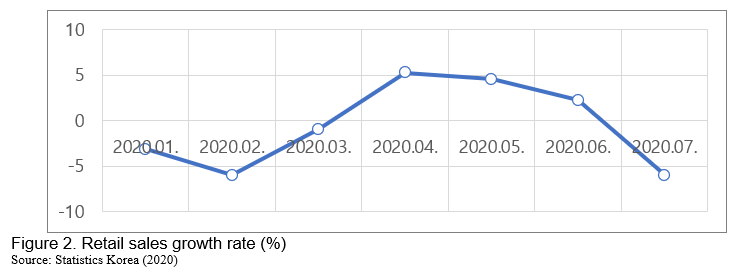
Voucher-based stimulus program
Voucher-based stimulus programs distribute discount vouchers, which can be used for specific products. Since people can buy the products/services with discounted price, it can stimulate expenditures for specific industries. The Korean government has implemented several vouchers for significantly damaged industries, like lodging, tourism, exhibition, agricultural and marine products, etc. Table 2 shows the list of voucher-based stimulus programs that are implemented in Korea. This study analyzes the voucher-based stimulus program for food services.

FOOD SERVICES CONSUMPTION STIUMUS PROGRAM
Introduction of food services consumption stimulus program
Food services consumption stimulus program had been implemented to help the severely damaged food service industries. Initially, the program is designed to cash back 20% of food services consumption at the sixth time of more than KRW20,000 (US$16.0) weekend transactions. In addition, to help recover to daily life, the program included visiting food service consumption. However, there was a rapid spread of COVID-19 at the starting point of the program. As a result, the Korean government suspended the program and modified it to a contactless food service only program. In addition, to increase the effectiveness of the program, the Korean government removed the day of week restriction, and reduced to four times the number of cashback transactions.
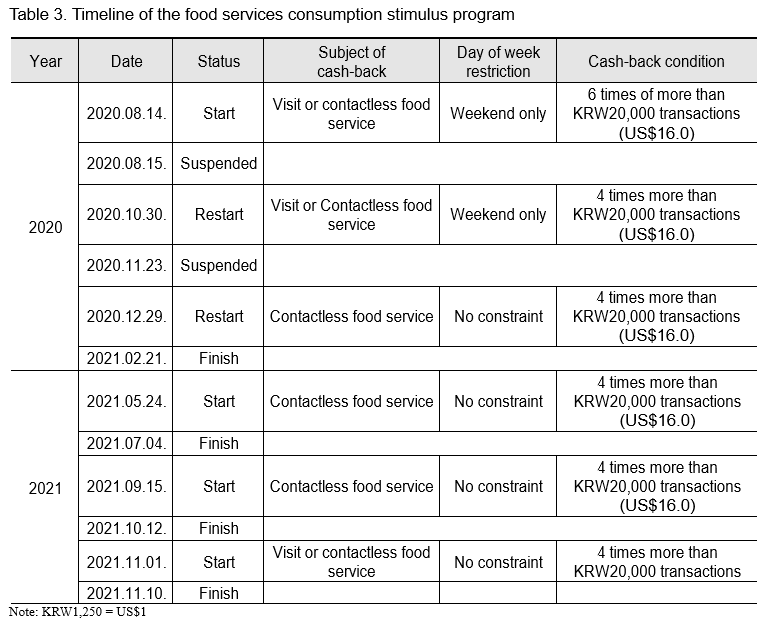
Theoretical background
Voucher-based stimulus programs have similar effects to discounting. Voucher discounts prices of goods/services are given so that people can buy more goods/services with the same budgets. Q and Y in Figure 3 are voucher-usable goods/services and other goods/services, respectively. Without a voucher, the person buys  voucher-usable goods/services and
voucher-usable goods/services and  other goods/services. Since vouchers have the same effects as a discount, the voucher can move the budget line to the right, while no change of the point on Y. Therefore, the budget line movement changes the utility maximization point as increasing in both voucher available goods/services and other goods/services.
other goods/services. Since vouchers have the same effects as a discount, the voucher can move the budget line to the right, while no change of the point on Y. Therefore, the budget line movement changes the utility maximization point as increasing in both voucher available goods/services and other goods/services.
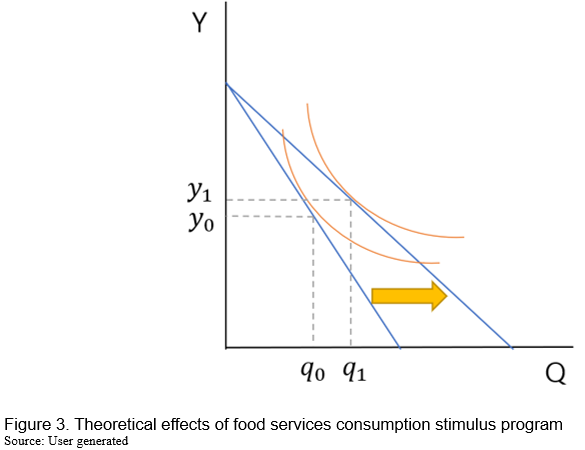
There is a possibility of increasing consumption of other goods/services without a change of consumption in the food service industry, in contrast to the theoretical effects. Basically, consumers with high price elasticity will spend more in the food service industry with food service vouchers. On the other hand, the voucher may increase disposable income by providing discounts, which is called the income effect. Consequently, the increased disposable income may be used for spending on goods/services other than food services. Therefore, an analysis of the voucher effects is needed.
Empirical model for effect analysis
Data
This study used the sales data of 8 main credit card companies among 9 participating companies of the food services consumption stimulus program. The analysis data were provided on weekends and weekdays from June 29, 2020, to February 21, 2021. The data consists of the total amount and number of credit card transactions from the food services industry (restaurants and delivery). In addition, the total amount and number of payments of more than KRW20,000 (US$16.0) in a transaction are also provided.
The data showed that sales from delivery applications and restaurants accounted for 7.1% and 92.9%, respectively. In addition, most of the food services users were less than age 70. Consumers who applied for the food services consumption stimulus program were about 9.9% of the total payment amount.

In addition, it was found that the amount of payment per case of the program applicants was slightly lower on average than that of non-applicants at the time before participating in the program. From this point of view, the applicant group may have the characteristic of eating out at a slightly lower price than the non-applicant group. These differences by groups can be seen as the basis for controlling the application group and the non-application group through the two-way error-fixed effect estimation method.

Empirical model
This study uses the difference-in-differences model (DID) to estimate the consumption stimulus effect of the food services consumption stimulus program. We compared the pre and post of food services expenditures of the program participant group (experimental group) and the non-participant group (control group). Comparing the food service expenditures pre and post of program cannot exclude the impact of existing changes or external factors such as COVID-19. Therefore, DID analysis was applied to analyze the policy effect. The basic DID model is as follows:


In this study, the two-way panel fixed effects estimation method was applied to control individual characteristics and time characteristics. Through this, even if there is a correlation between the error term and the explanatory variable for the individual characteristics and the time characteristics, the matching estimation coefficient can be derived. In addition, when estimating the DID model, the standard error of the coefficient may be reduced when estimating the DID model with a fixed effect rather than linear regression, thereby it can improve the fit of the model.

Results of effect analysis
The results of the first round of the food services consumption stimulus program show that participants have a 6.8% higher total payment amount than non-participants. The number of payments increased by 5.3%. If we restrict the total payment amount to over KRW20,000 (US$16.0) transactions, then the participants have an 8.2% higher total payment amount than non-participants. The results for the number of transactions with more than KRW20,000 (US$16.0) show 9.5% higher. The higher increase in over KRW20,000 (US$16.0) transactions is possibly explained by the cashback condition.
On the other hand, it was analyzed that consumers who participated in the first period decreased by 1.5% compared to those who did not, which can be interpreted as consumers reducing the amount of payments when paying more than KRW20,000 (US$16.0) and increasing the number of payments.

The results of the second round of the food services consumption stimulus program show that participants have a 6.1% higher total payment amount than non-participants. The number of payments increased by 3.6%. If we restrict the total payment amount to over KRW20,000 (US$16.0) transactions, then the participants have an 9.3% higher total payment amount than non-participants. The results for the number of transactions with more than KRW20,000 (US$16.0) show 11.6% higher. The higher increase in over KRW20,000 (US$16.0) transactions is possibly explained by the cashback condition.
On the other hand, it was analyzed that consumers who participated in the first period decreased by 2.4% compared to those who did not, which can be interpreted as consumers reducing the amount of payment when paying more than KRW20,000 (US$16.0) and increasing the number of payments.
Comparing the impact of the first and second round on food services sales, the effect of the first round was slightly greater on average than the effect of the second round. It seems that the policy method of the first round, which provided visiting food services discount, had potentially a higher effect of boosting consumption of food services than the second round.
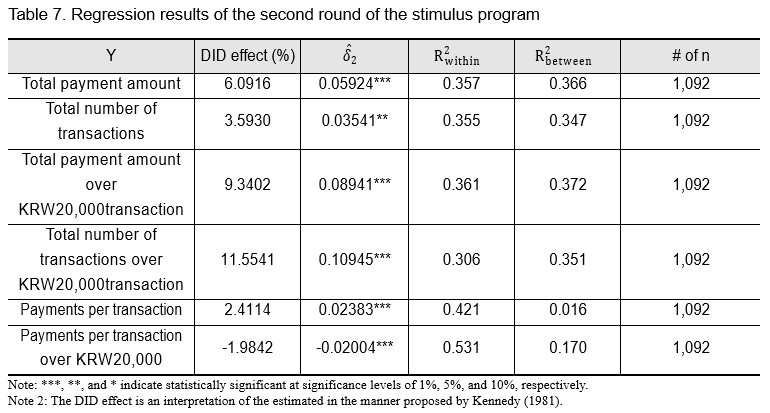
We estimated the increased sales by the program based on the above analysis results. The average weekly value of the total sales of the food services industry in 2020 is KRW2,194 billion (US$1,755.2 million). In addition, we used the sales data of the food services industry by credit card companies to utilize the share of weekend sales in the industry's weekly sales, and although there is a slight difference from month to month, it was found to be 50%. Based on this, the average portion of the program participants' payment accounted for 10.4%. As a result, the total sales of the food services industry increased due to the first period of the program was about KRW36.1 billion (US$28.9 million), and increased sales in the second period was KRW87.6 billion (US$70.1 million). The total increased sales due to the program was estimated about KRW123.8 billion (US$99.0 million).
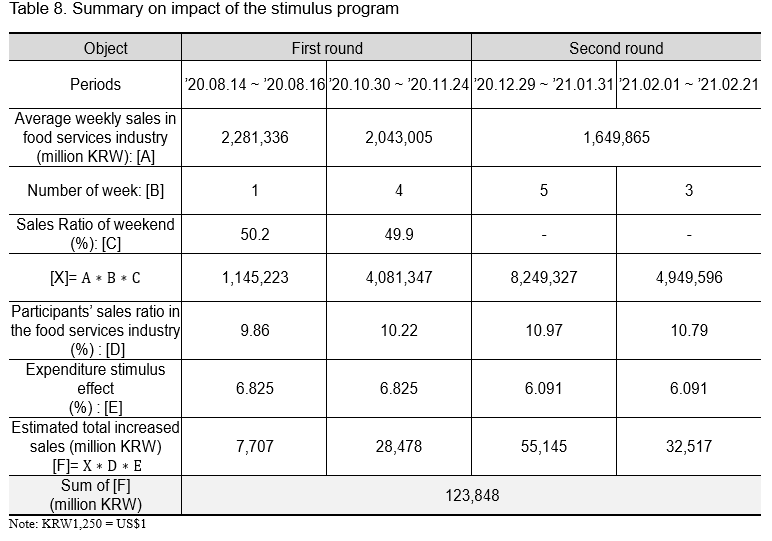
CONCLUSION
The COVID-19 pandemic has dampened the Korean food service industry. The Korean government has prepared a policy to support food service consumption in order to support the industry, which has been highly damaged by the COVID-19 pandemic. The government announced “the food services consumption stimulus program,” which refunded a 20% limit of KRW10,000 (US$8.0) for the next batch if consumers used the food service a certain number of times when it was deemed necessary to boost consumption.
We analyzed the two-way panel fixed effects DID model using credit card company sales data to evaluate the effectiveness of the food services consumption stimulus program. As a result of the analysis, consumption of food services increased statistically significantly compared to the comparative group either the first or second periods. Compared to the comparative group, it was analyzed that the effect of increasing sales was 7.9% in the first period and 25% in the second period. The total sales volume increased to the food services consumption stimulus program in the Korean food service industry as a whole was analyzed to be KRW123.8 billion (US$99.0 million).
The food services consumption stimulus program budget is about KRW38.3 billion (US$30.6 million), which generated an additional 3.23 times of the consumption expenditure for food services with one unit of the policy budget. It suggests that the policy can be cost-effective. The program achieved two conflicting policy objectives: quarantine activities and economic revitalization. In addition, the increase in transfer income through the food service consumption stimulus program is expected to have ripple effects in various parts of the economy in the future. This study can be used as basic data for designing and evaluating similar policies and programs.
REFERENCES
Kennedy, P. E. (1981). Estimation with correctly interpreted dummy variables in semilogarithmic equations [the interpretation of dummy variables in semilogarithmic equations]. American Economic Review, 71(4), 801–801.
Kim, M., & Oh, Y. (2020). Effects and implications of emergency relief payment. KDI Policy Forum
Korea Rural Economic Institute. (2023). Agricultural Food Consumption Analysis.
Ministry of Culture, Sports and Tourism. (n.d.). Consumption stimulus programs in Korea. Retrieved December 30, 2022, from https://www.korea.kr/news/visualNewsView.do?newsId=148895030
Ministry of Economy and Finance. (2021). Recovery for All: Korea’s Fiscal Response to COVID-19.
Statistics Korea. (2020a). Household Expenditure Survey.
Statistics Korea. (2020b). Industrial Activity Trends.
[1] The exchange rate between KRW and USD in this article is US$1=KRW1,250.


Analysis of COVID-19 Relief Program: Focus on Food Services Stimulus Program of South Korea
ABSTRACT
The South Korean government had implemented dining business stimulus programs to cushion the damage by COVID-19. The dining discount coupon was distributed as one of the stimulus policies. This study analyzed the effects of food services stimulus program on food service expenditure with big data, like Point-of-Sales data and credit card usage data. The results show stimulus program has increased restaurant business consumption by 2.3 times of the program budget. This study shows that consumption stimulus programs can be one of the possible policies in the hand of the governments. Similar consumption revitalization programs are likely to be promoted in the future at a time when COVID-19 is prolonged, the spread of periodic infectious diseases, and the resulting economic downturn are expected. This study can be used as basic data for designing and evaluating similar policies and programs.
Keywords: Food consumption, Expenditure Stimulus Program, Voucher-based consumption stimulus program
INTRODUCTION
The outbreak and spreading of COVID-19 have changed usual daily life. Social distancing and lock-downs had increased contactless food services, simultaneously it had decreased visiting food services. As a result, closure rate of food services was much higher compared to other industries.
South Korea is no exception to the recent trends of behavioral change. The outbreak and rapid spread of COVID-19 have increased the proportion of households with no food-away-from-home expenditures from 18.1% in 2019 to 27.8% in 2021 (Korea Rural Economic Institute, 2022). The behavioral change in food-away-from-home have drastically decreased food-away-from-home expenditures from KRW333,562 (US$266.8[1]) in 2019 to KRW308,977 (US$247.2) in 2020 (Statistics Korea, 2022). Therefore, food service industry is severely damaged by COVID-19.
This study introduces food service consumption stimulus programs in Korea. Especially, this study focuses on the food services consumption stimulus program, which was implemented from 2020 to 2021 as a response to COVID-19. The food services consumption stimulus program is a voucher-based stimulus program, which provides discounts for specific food service products. Although it may stimulate expenditures in the food service industry, there is a possibility of low stimulus effects. Therefore, this study analyzes the consumption stimulus effects of the food services consumption stimulus program.
This study contributes to the policy design in two ways. First, to the best of the authors’ knowledge, this study proves that the voucher-based stimulus program is necessary for severely damaged industry. Second, this study shows that the policy needs to be designed with flexibility.
The rest of this study will be as follows. Consumption stimulus programs in Korea are briefly described. Then, the food service consumption stimulus program is introduced with its detailed designs. After the introduction, the theoretical background, and empirical model are introduced. Then, the results will be presented.
CONSUMPTION STIMULUS PROGRAMS IN KOREA
Cash transfer stimulus program
Cash transfer stimulus programs encourage consumption by providing additional cash. Cash support increases available cash to use, thus it can stimulate expenditures. The Korean government implemented a cash transfer stimulus program and an emergency relief payment. It was distributed to households regardless of income levels from May to August 2020. The amount of support is determined by the size of households, as described in Table 1. A total of KRW12.2 trillion (US$9,760 million) was distributed, and the distribution changes the negative growth rate in retail sales to positive.
The emergency relief payment successfully achieved its objective, which was a stimulus of consumption. However, the effects of the program were short. From July 2020, the retail sales growth rate became negative at -6% (Statistics Korea, 2020). Moreover, its consumption stimulus effects on the significantly damaged industries were small, e.g., consumption increase in the food service industry was only 3% (Kim et al., 2020). Therefore, industry-specific discount coupon-based programs are needed to encourage consumption of specific industries.
Voucher-based stimulus program
Voucher-based stimulus programs distribute discount vouchers, which can be used for specific products. Since people can buy the products/services with discounted price, it can stimulate expenditures for specific industries. The Korean government has implemented several vouchers for significantly damaged industries, like lodging, tourism, exhibition, agricultural and marine products, etc. Table 2 shows the list of voucher-based stimulus programs that are implemented in Korea. This study analyzes the voucher-based stimulus program for food services.
FOOD SERVICES CONSUMPTION STIUMUS PROGRAM
Introduction of food services consumption stimulus program
Food services consumption stimulus program had been implemented to help the severely damaged food service industries. Initially, the program is designed to cash back 20% of food services consumption at the sixth time of more than KRW20,000 (US$16.0) weekend transactions. In addition, to help recover to daily life, the program included visiting food service consumption. However, there was a rapid spread of COVID-19 at the starting point of the program. As a result, the Korean government suspended the program and modified it to a contactless food service only program. In addition, to increase the effectiveness of the program, the Korean government removed the day of week restriction, and reduced to four times the number of cashback transactions.
Theoretical background
Voucher-based stimulus programs have similar effects to discounting. Voucher discounts prices of goods/services are given so that people can buy more goods/services with the same budgets. Q and Y in Figure 3 are voucher-usable goods/services and other goods/services, respectively. Without a voucher, the person buys voucher-usable goods/services and
voucher-usable goods/services and  other goods/services. Since vouchers have the same effects as a discount, the voucher can move the budget line to the right, while no change of the point on Y. Therefore, the budget line movement changes the utility maximization point as increasing in both voucher available goods/services and other goods/services.
other goods/services. Since vouchers have the same effects as a discount, the voucher can move the budget line to the right, while no change of the point on Y. Therefore, the budget line movement changes the utility maximization point as increasing in both voucher available goods/services and other goods/services.
There is a possibility of increasing consumption of other goods/services without a change of consumption in the food service industry, in contrast to the theoretical effects. Basically, consumers with high price elasticity will spend more in the food service industry with food service vouchers. On the other hand, the voucher may increase disposable income by providing discounts, which is called the income effect. Consequently, the increased disposable income may be used for spending on goods/services other than food services. Therefore, an analysis of the voucher effects is needed.
Empirical model for effect analysis
Data
This study used the sales data of 8 main credit card companies among 9 participating companies of the food services consumption stimulus program. The analysis data were provided on weekends and weekdays from June 29, 2020, to February 21, 2021. The data consists of the total amount and number of credit card transactions from the food services industry (restaurants and delivery). In addition, the total amount and number of payments of more than KRW20,000 (US$16.0) in a transaction are also provided.
The data showed that sales from delivery applications and restaurants accounted for 7.1% and 92.9%, respectively. In addition, most of the food services users were less than age 70. Consumers who applied for the food services consumption stimulus program were about 9.9% of the total payment amount.
In addition, it was found that the amount of payment per case of the program applicants was slightly lower on average than that of non-applicants at the time before participating in the program. From this point of view, the applicant group may have the characteristic of eating out at a slightly lower price than the non-applicant group. These differences by groups can be seen as the basis for controlling the application group and the non-application group through the two-way error-fixed effect estimation method.
Empirical model
This study uses the difference-in-differences model (DID) to estimate the consumption stimulus effect of the food services consumption stimulus program. We compared the pre and post of food services expenditures of the program participant group (experimental group) and the non-participant group (control group). Comparing the food service expenditures pre and post of program cannot exclude the impact of existing changes or external factors such as COVID-19. Therefore, DID analysis was applied to analyze the policy effect. The basic DID model is as follows:
In this study, the two-way panel fixed effects estimation method was applied to control individual characteristics and time characteristics. Through this, even if there is a correlation between the error term and the explanatory variable for the individual characteristics and the time characteristics, the matching estimation coefficient can be derived. In addition, when estimating the DID model, the standard error of the coefficient may be reduced when estimating the DID model with a fixed effect rather than linear regression, thereby it can improve the fit of the model.
Results of effect analysis
The results of the first round of the food services consumption stimulus program show that participants have a 6.8% higher total payment amount than non-participants. The number of payments increased by 5.3%. If we restrict the total payment amount to over KRW20,000 (US$16.0) transactions, then the participants have an 8.2% higher total payment amount than non-participants. The results for the number of transactions with more than KRW20,000 (US$16.0) show 9.5% higher. The higher increase in over KRW20,000 (US$16.0) transactions is possibly explained by the cashback condition.
On the other hand, it was analyzed that consumers who participated in the first period decreased by 1.5% compared to those who did not, which can be interpreted as consumers reducing the amount of payments when paying more than KRW20,000 (US$16.0) and increasing the number of payments.
The results of the second round of the food services consumption stimulus program show that participants have a 6.1% higher total payment amount than non-participants. The number of payments increased by 3.6%. If we restrict the total payment amount to over KRW20,000 (US$16.0) transactions, then the participants have an 9.3% higher total payment amount than non-participants. The results for the number of transactions with more than KRW20,000 (US$16.0) show 11.6% higher. The higher increase in over KRW20,000 (US$16.0) transactions is possibly explained by the cashback condition.
On the other hand, it was analyzed that consumers who participated in the first period decreased by 2.4% compared to those who did not, which can be interpreted as consumers reducing the amount of payment when paying more than KRW20,000 (US$16.0) and increasing the number of payments.
Comparing the impact of the first and second round on food services sales, the effect of the first round was slightly greater on average than the effect of the second round. It seems that the policy method of the first round, which provided visiting food services discount, had potentially a higher effect of boosting consumption of food services than the second round.
We estimated the increased sales by the program based on the above analysis results. The average weekly value of the total sales of the food services industry in 2020 is KRW2,194 billion (US$1,755.2 million). In addition, we used the sales data of the food services industry by credit card companies to utilize the share of weekend sales in the industry's weekly sales, and although there is a slight difference from month to month, it was found to be 50%. Based on this, the average portion of the program participants' payment accounted for 10.4%. As a result, the total sales of the food services industry increased due to the first period of the program was about KRW36.1 billion (US$28.9 million), and increased sales in the second period was KRW87.6 billion (US$70.1 million). The total increased sales due to the program was estimated about KRW123.8 billion (US$99.0 million).
CONCLUSION
The COVID-19 pandemic has dampened the Korean food service industry. The Korean government has prepared a policy to support food service consumption in order to support the industry, which has been highly damaged by the COVID-19 pandemic. The government announced “the food services consumption stimulus program,” which refunded a 20% limit of KRW10,000 (US$8.0) for the next batch if consumers used the food service a certain number of times when it was deemed necessary to boost consumption.
We analyzed the two-way panel fixed effects DID model using credit card company sales data to evaluate the effectiveness of the food services consumption stimulus program. As a result of the analysis, consumption of food services increased statistically significantly compared to the comparative group either the first or second periods. Compared to the comparative group, it was analyzed that the effect of increasing sales was 7.9% in the first period and 25% in the second period. The total sales volume increased to the food services consumption stimulus program in the Korean food service industry as a whole was analyzed to be KRW123.8 billion (US$99.0 million).
The food services consumption stimulus program budget is about KRW38.3 billion (US$30.6 million), which generated an additional 3.23 times of the consumption expenditure for food services with one unit of the policy budget. It suggests that the policy can be cost-effective. The program achieved two conflicting policy objectives: quarantine activities and economic revitalization. In addition, the increase in transfer income through the food service consumption stimulus program is expected to have ripple effects in various parts of the economy in the future. This study can be used as basic data for designing and evaluating similar policies and programs.
REFERENCES
Kennedy, P. E. (1981). Estimation with correctly interpreted dummy variables in semilogarithmic equations [the interpretation of dummy variables in semilogarithmic equations]. American Economic Review, 71(4), 801–801.
Kim, M., & Oh, Y. (2020). Effects and implications of emergency relief payment. KDI Policy Forum
Korea Rural Economic Institute. (2023). Agricultural Food Consumption Analysis.
Ministry of Culture, Sports and Tourism. (n.d.). Consumption stimulus programs in Korea. Retrieved December 30, 2022, from https://www.korea.kr/news/visualNewsView.do?newsId=148895030
Ministry of Economy and Finance. (2021). Recovery for All: Korea’s Fiscal Response to COVID-19.
Statistics Korea. (2020a). Household Expenditure Survey.
Statistics Korea. (2020b). Industrial Activity Trends.
[1] The exchange rate between KRW and USD in this article is US$1=KRW1,250.